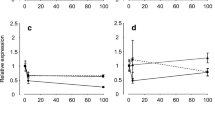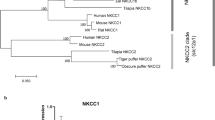Summary
Branchial chloride cells, which actively take up ions in the gills of freshwater fish, were studied in tilapia (Oreochromis mossambicus) exposed to sublethally acidified freshwater. Structural damage of cells, resulting in cell death by necrosis, only occurred transiently, when the reduction of water pH was acute rather than gradual. The most prominent effects of water acidification were the rapid increase in the number of chloride cells and the changes in frequency of the different stages of the chloride cell cycle. In the opercular inner epithelium, a twofold increase in cells occurred 48 h after gradual acidification. Cell density stabilized after 4 weeks at a level 5 times that of control fish. Four transitory stages were distinguished in the chloride cell cycle: accessory or replacement cells, immature, mature, and degenerating (apoptotic) cells. In control fish, mature chloride cells dominated (over 50%) with immature and apoptotic cells totalling about 40%. After 4 weeks in acid water, only 13% of the cells were mature. Immature and apoptotic cells dominated, each representing about 40% of the total number of chloride cells. Mature cells apparently age rapidly under these conditions. Thus, chloride cells turn over quickly in acid water, with a minor increase in ion transport capacity of the gills. This conclusion is supported by the observation that opercular and branchial Na+/K+ ATPase activities in treated fish are only 40%–50% higher than in controls.
Similar content being viewed by others
References
Avella M, Masoni A, Bornancin M, Mayer-Gostan N (1987) Gill morphology and sodium influx in the rainbow trout (Salmo gairdneri) acclimated to artificial freshwater environments. J Exp Zool 241:159–169
Balm P, Goossen N, De Rijke S, Wendelaar Bonga S (1988) Characterization of Na+-ATPases in gills of freshwater tilapia. Evidence for branchial Na+/H+ (NH4 +)-ATPase activity in fish gills. Fish Physiol Biochem 5:31–38
Bereiter-Hahn J (1976) Dimethylaminostyrylmethylpyridiniumiodine as a fluorescent probe for mitochondria in situ. Biochem Biophys Acta 423:1–14
Bursch W, Taper HS, Lauer B, Schulte-Hermann R (1985) Quantitative histological and histochemical studies on the occurrence and stages of controlled cell death (apoptosis) during regression of rat liver hyperplasia. Virchows Arch [B] 50:153–166
Chevalier G, Gauthier L, Moreau G (1985) Histopathological and electron microscopic studies of gills of brook trout,Salvelinus fontinalis, from acidified lakes. Can J Zool 63:2062–2070
Chrétien M, Pisam M (1986) Cell renewal and differentiation in the gill epithelium of fresh- or salt-water-adapted euryhaline fish as revealed by [3H]-thymidine autoradiography. Biol Cell 56:137–150
Daoust PY, Wobeser G, Newstead JD (1984) Acute pathological effects of inorganic mercury and copper in gills of rainbow trout. Vet Pathol 21:93–101
Daye P, Garside E (1976) Histopathologic changes in surficial tissues of brook trout,Salvelinus fontinalis (Mitchill), exposed to acute and chronic levels of pH. Can J Zool 54:2140–2155
Dunel-Erb S, Laurent P (1980) Ultrastructure of marine teleost gill epithelia: SEM and TEM study of the chloride cell apical membrane. J Morphol 165:175–186
Flik G, Wendelaar Bonga SE, Fenwick JC (1983) Ca2+-dependent phosphatase and ATPase activities in eel gill plasma membranes I. Identification of Ca2+-activated ATPase activities with nonspecific phosphatase activities. Comp Biochem Physiol 76B:745–754
Flik G, Fenwick JC, Kolar Z, Mayer-Gostan N, Wendelaar Bonga SE (1985a) Whole body calcium flux rates in cichlid teleost fishOreochromis mossambicus adapted to freshwater. Am J Physiol 249:R432–4377
Flik G, Van Rijs JH, Wendelaar Bonga SE (1985b) Evidence for high-affinity Ca2+-ATPase activity and ATP-driven Ca2+ transport in membrane preparations of the gill epithelium of the cichlid fishOreochromis mossambicus. J Exp Biol 119:335–347
Flik G, Van der Velden JA, Seegers HCM, Kolar Z, Wendelaar Bonga SE (1989) Prolactin cell activity and sodium fluxes in tilapia (Oreochromis mossambicus) after long-term acclimation to acid water. Gen Comp Endocrinol 75:39–45
Foskett JK, Scheffey C (1982) The chloride cell: definitive identification as the salt-secretory cell in teleosts. Science 215:164–166
Foskett JK, Logsdon CD, Turner T, Machen TE, Bern HA (1981) Differentiation of the chloride extrusion mechanism during seawater adaptation of a teleost fish, the cichlidSarotherodon mossambicus. J Exp Biol 93:209–224
Hootman SR, Philpott CW (1979) Ultracytochemical localization of Na+, K+-activated ATPase in chloride cells from the gills of a euryhaline teleost. Anat Rec 193:99–130
Hootman SR, Philpott CW (1980) Accessory cells in teleost branchial epithelium. Am J Physiol 238:R199-R206
Hwang PP (1988) Multicellular complex of chloride cells in teleost branchial epithelium. Am J Physiol 238:R199-R206
Hwang PP, Hirano H (1985) Effects of environmental salinity on intercellular organization and junctional structure of chloride cells in early stages of teleost development. J Exp Zool 236:115–126
Jagoe JH, Haines TA (1983) Alterations in gill epithelial morphology of yearling sunapee trout exposed to acute acid stress. Trans Am Fish Soc 112:689–695
Lacy ER (1983) Histochemical and biochemical studies of carbonic anhydrase activity in the opercular epithelium of the euryhaline teleost,Fundulus heteroclitus. Am J Anat 166:19–39
Laurent P (1984) Gill internal morphology. In: Hoar WS, Randall DJ (eds) Fish physiology, vol 10a. Academic Press, New York, pp 73–183
Laurent P, Dunel S (1980) Morphology of gill epithelia in fish. Am J Physiol 238:R147–159
Laurent P, Höbe H, Dunel-Erb S (1985) The role of environmental sodium chloride relative to calcium in gill morphology of freshwater salmonid fish. Cell Tissue Res 240:675–692
Leino RL, McCormick JH (1984) Morphological and morphometrical changes in chloride cells of the gills ofPimephelas promelas after chronic exposure to acid water. Cell Tissue Res 236:121–128
Leino RL, McCormick JH, Jensen KM (1987) Changes in gill histology of fathead minnows and yellow perch transferred to soft water or acidified soft water with particular reference to chloride cells. Cell Tissue Res 250:389–399
Mallatt J (1985) Fish gill structural changes induced by toxicants and other irritants: a statistical review. Can J Fish Aquat Sci 42:630–648
McDonald DG (1983) The effects of H+ upon the gills of freshwater fish. Can J Zool 61:691–703
Mayer-Gostan N, Wendelaar Bonga SE, Balm PHM (1987) Mechanisms of hormone actions on gill transport. In: Pang PKT, Schreibman MP (eds) Vertebrate endocrinology: fundamentals and biomedical implications, vol. 2. Academic Press, Orlando, pp 211–238
Payan P, Mayer-Gostan N, Pang PKT (1981) Site of calcium uptake in the freshwater trout gill. J Exp Zool 216:345–347
Pisam M (1981) Membranous systems in the “chloride cells” of teleostan fish gill; their modifications in response to the salinity of the environment. Anat Rec 200:401–414
Pisam M, Prunet P, Boeuf G, Rambourg A (1988) Ultrastructural features of chloride cells in the gill epithelium of the Atlantic salmon,Salmo salar, and their modifications during smoltification. Am J Anat 183:235–244
Pisam M, Prunet P, Rambourg A (1989) Accessory cells in the gill epithelium of the freshwater rainbot troutSalmo gairdneri. Am J Anat 184:311–320
Sardet C, Pisam M, Maetz J (1979) The surface epithelium of teleostean fish gills. Cellular and junctional adaptations of the chloride cell in relation to salt adaptation. J Cell Biol 80:96–117
Schoots AFM, Evertse PACM, Denucé JM (1983) Ultrastructural changes in hatching-gland cells of pike embryos (Esox lucius L.) and evidence for their degeneration by apoptosis. Cell Tissue Res 229:573–589
Tondeur F, Sargent JR (1979) Biosynthesis of macromolecules in chloride cells in the gills of common eel,Anguilla anguilla, adapting to seawater. Comp Biochem Physiol 62B:13–16
Wendelaar Bonga SE, Dederen LHT (1986) Effects of acidified water on fish. Endeavour 10:198–202
Wendelaar Bonga SE, Pang PKT (1986) Stannius corpuscles. In: Pang PKT, Schreibman MP (eds) Vertebrate endocrinology: fundamentals and biomedical implications, vol. 1. Academic Press, Orlando, pp 439–464
Wendelaar Bonga SE, Van der Meij JCA (1989) Degeneration and death, by apoptosis and necrosis, of the pavement and chloride cells in the gills of the teleostOreochromis mossambicus. Cell Tissue Res 255:235–243
Wyllie AH (1981) Cell death: a new classification separating apoptosis from necrosis. In: Bowen ID, Lockshin RA (eds) Cell death in biology and pathology. Chapman and Hall, London, pp 9–34
Wyllie AH, Kerr JFR, Currie AR (1980) Cell death: the significance of apoptosis. Int Rev Cytol 68:251–306
Author information
Authors and Affiliations
Rights and permissions
About this article
Cite this article
Wendelaar Bonga, S.E., Flik, G., Balm, P.H.M. et al. The ultrastructure of chloride cells in the gills of the teleostOreochromis mossambicus during exposure to acidified water. Cell Tissue Res. 259, 575–585 (1990). https://doi.org/10.1007/BF01740786
Accepted:
Issue Date:
DOI: https://doi.org/10.1007/BF01740786




